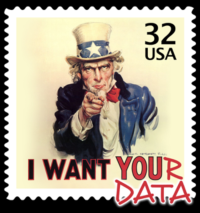By: Eric Siegel, Founder, Predictive Analytics World
The NSA can leverage bulk data collection with predictive analytics to target law enforcement activities. But this little-known capability both intensifies and redefines the debate over how much data governments should be collecting.
About this article. This article is excerpted from the Revised and Updated edition of Eric Siegel’s book, Predictive Analytics: The Power to Predict Who Will Click, Buy, Lie, or Die. For more on predictive policing, fraud detection, and related applications, attend the Predictive Analytics World for Government’s 6th Annual Conference (October 17-20, 2016 in Washington, DC). Also, a complementary copy of this book will be provided for attendees at two other Predictive Analytics World events coming in October to New York: PAW Business and PAW Financial.
The U.S.’s National Security Agency (NSA) has endured intense global scrutiny and suffered heavy backlash over its mass data collection that was unveiled in detail by whistleblower Edward Snowden in 2013. But don’t give too much credence to the news or even the books—public discourse leaves out the greatest power law enforcement stands to gain from this data.
Summary of the mainstream debate regarding NSA data collection:
Privacy advocates: The NSA is violating civil liberties by collecting data on a massive scale about private citizens, including the majority who are not even suspected of any wrongdoing. Access to this data, whether in-house or by proxy via telecom companies, facilitates arbitrary snooping.
The NSA (and supportive legislators): We require comprehensive data in-house so we can rapidly investigate specific individuals when they become of interest. We do not inspect the activities of ordinary civilians in general.
This contentious dialogue only touches on half the story. Both sides — including the most visible critics of the recent NSA bulk data shutdown — fail to address what’s really at stake for law enforcement: Data empowers not only the investigation of established suspects, but also the discovery of new suspects. I would like to propose the following terminology for this emerging form of data driven law enforcement:
Automatic Suspect Discovery (ASD)—The identification of previously unknown potential suspects by applying predictive analytics to flag and rank individuals according to their likelihood to be worthy of investigation, either because of their direct involvement in, or relationship to, criminal activities.
ASD provides a novel means to unearth new suspects. Using it, law enforcement can hunt scientifically, more effectively targeting its search by applying predictive analytics, the same state-of-the-art, data-driven technology behind fraud detection, financial credit scoring, spam filtering, and targeted marketing.
How It Works: Why the Whole Haystack Is Needed to Shrink the Haystack
 To harness this potential, law enforcement needs the “whole haystack.” The government doesn’t desire data about you just to spy at will—on the off chance you turn out to be a suspect. Rather, they actually require this data as a baseline in order to pursue their greater objective with ASD. This approach relies on wide-scale data access, even including data about both you and me—a full regimen of data about normal, innocent civilian activity unrelated to crime of any sort. Mathematically speaking, the broader a swath of noncriminal cases fed into the analysis, the better it works.
To harness this potential, law enforcement needs the “whole haystack.” The government doesn’t desire data about you just to spy at will—on the off chance you turn out to be a suspect. Rather, they actually require this data as a baseline in order to pursue their greater objective with ASD. This approach relies on wide-scale data access, even including data about both you and me—a full regimen of data about normal, innocent civilian activity unrelated to crime of any sort. Mathematically speaking, the broader a swath of noncriminal cases fed into the analysis, the better it works.
Law enforcement (antiterrorism or otherwise) is a numbers game, a quest to find needles in the haystack that is the general population. The working hours spent by agents, officers, and analysts constitute a precious, finite resource that must be allocated as effectively as possible. As staff collects evidence, follows leads, and studies forensics, there is no magic oracle to focus these efforts and ensure the quest is efficient. But predictive analytics can better target a portion of the work, focusing it on individuals predicted more likely to be of interest.
As with fraud detection, prediction shrinks the haystack to be searched. This multiplies the effectiveness of available human resources. By focusing time on the top echelon, those with the highest predictive scores, an investigator is more likely to come across worthy suspects. While it is reasonable to assume ASD pays off over time, investigators must understand the odds have only shifted; it’s not a magic crystal ball. Most targets of investigation still turn out to be innocent—that is to say, the false positive rate will be lowered but by no means eliminated; the haystack is smaller but still large.
But this requires bulk data. As with all application areas, predictive analytics learns from data that encodes both positive and negative cases—in this case, both known needles, e.g., perpetrators or suspects, and the vast haystack of ordinary civilians, respectively. The analytical number-crunching process builds models (e.g., patterns or other formulations) to distinguish needles from hay. The effectiveness of this process depends on access to bulk data.
Presumption: The NSA Uses Predictive Analytics
It’s a foregone conclusion the National Security Agency (NSA) considers predictive analytics a strategic priority. While, any such activities are necessarily a secret, wondering whether they use it is like speculating whether a chef who bought flat pasta, meat sauce, mozzarella, and ricotta is making lasagna. Beyond a reasonable doubt, the world’s largest spy organization running the country’s largest surveillance data center and employing the world’s largest number of Ph.D. mathematicians strives to analytically learn from data.
There’s much supporting the presumption that the NSA has worked with predictive analytics and will continue to do so. Official documents established NSA capabilities in machine learning; the NSA has purchased intelligence software solutions that include predictive analytics capabilities. NSA job postings for “data scientists” seek candidates experienced with machine learning and other related technologies. The FBI applies predictive analytics for terrorism, and, more generally this technology stands clear as an increasingly common practice for law enforcement of all kinds, including U.S. Armed Forces-funded terrorism prediction, predictive policing, and recidivism prediction, as well as fraud detection, arguably the leading government application of predictive analytics.
Example Patterns: What It Could Discover
With this in mind, let’s look at what the NSA could discover with predictive analytics…
To access the rest of this article, click here for the original publication in The European Business Review (free registration required)
 Adapted with permission of the publisher from Predictive Analytics: The Power to Predict Who Will Click, Buy, Lie, or Die, Revised and Updated Edition (Wiley, January 2016) by Eric Siegel, Ph.D. Eric Siegel, Ph.D., founder of the Predictive Analytics World and Deep Learning World conference series and executive editor of The Machine Learning Times, makes the how and why of predictive analytics (aka machine learning) understandable and captivating. He is the author of the award-winning book Predictive Analytics: The Power to Predict Who Will Click, Buy, Lie, or Die, the host of The Dr. Data Show web series, a former Columbia University professor, and a renowned speaker, educator, and leader in the field. Follow him at @predictanalytic.
Adapted with permission of the publisher from Predictive Analytics: The Power to Predict Who Will Click, Buy, Lie, or Die, Revised and Updated Edition (Wiley, January 2016) by Eric Siegel, Ph.D. Eric Siegel, Ph.D., founder of the Predictive Analytics World and Deep Learning World conference series and executive editor of The Machine Learning Times, makes the how and why of predictive analytics (aka machine learning) understandable and captivating. He is the author of the award-winning book Predictive Analytics: The Power to Predict Who Will Click, Buy, Lie, or Die, the host of The Dr. Data Show web series, a former Columbia University professor, and a renowned speaker, educator, and leader in the field. Follow him at @predictanalytic.
The Machine Learning Times © 2020 • 1221 State Street • Suite 12, 91940 •
Santa Barbara, CA 93190
Produced by: Rising Media & Prediction Impact

